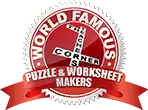 The Teacher's Corner
The Teacher's Corner
Paper Bag Book Reports
Grades: Any
Summary: Place items in a paper bag to represent parts of a story
Grade level: Grades 1-12 can complete this project.
Goals and Objectives: After selecting and reading a book independently, students will create a paper bag book report using an ordinary paper bag. Students should choose 5-7 items to place in the bag to represent significant events or characters from the book. For example, "Goldilocks and the Three Bears" might call for a soup spoon, a thermometer, a piece of doll house furniture, an ad for running shoes, etc. Students, after filling and decorating their bags, present them to the class. Each student should explain how the items he or she has chosen relate to the book. This makes for a fun oral presentation which exceeds the traditional book report for both the presenter and the audience.
Materials Required: Books Paper bags (large to lunch-size) Decorative items for the bag (markers, stickers, etc.)
Procedures:
1. The class reads a book together and the teacher demonstrates a sample paper bag book report. (This is optional--more appropriate for younger or lower functioning students.)
2. Each student chooses and reads a book independently, with teacher approval. (This can be modified if students are very low functioning--peer tutor or teacher reads book to them.)
3. Students analyze their books' characters, plots, themes, etc.
4. Students devise written plans for their bag book reports, detailing five to seven items for the inside as well as creating layouts for the outside of the bag. (The teacher may want to require title, author, and publisher on the front; an internal conflict on the left side; an external conflict on the right side; or a favorite scene on the back, for example.)
5. Provide time in class for students to complete their book report projects so they can see others working and have guided practice at fulfilling the promise of their written plans.
6. Students present their projects, in detail, to the class - first explaining the outside of their bags and then explaining each of the items inside. (Questions from the class come naturally and should be encouraged.)
7. Students can assess each other using a teacher-devised scoring rubric for both the bag and the presentation.
Assessment: Peer assessment of oral presentation; guided self-assessment of bag (inside and out) using a teacher-devised checklist/ scoring rubric; teacher assessment using checklist (The weight of peer evaluations, self-evaluation, and teacher evaluation will vary with student needs and grade level.)
Enhancement of Literacy Skills: Independent book selection, independent reading, analysis of plot, character and/ or theme, oral presentation, creativity.
Across Curriculum:
*If a student has selected a book which is appropriate in a social studies or science lesson, use this as an introduction to the topic.
*Allow students to write about the items in their paper bags, and/or about the book they read. Why did the select the book? Why did they select the items? What was their favorite part of the book?
*For younger grades, count the items in the bags. Add the items together. How many items did everyone in the whole class use?
*For older grades, use the items for probability. What is the probability I will draw an item that starts with "p"?
Source: An AskERIC Lesson Plan submitted by Cecilia Hoff
Submitted by: TamiLarsen@email-removed
